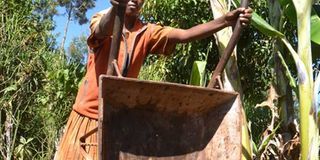Four simple steps to make compost manure at home

Evelyn Wangui applies manure to her banana plants at Murugu, Nyeri, before the start of the long rains. PHOTO | FILE
What you need to know:
- With fertiliser prices rising regularly, making own compost manure can help a farmer save a great deal
Compost manure is rotten plant and animal waste. Composting produces an organic fertiliser high in plant nutrients which improves soil physical characteristics, reduces organic waste on the farm and eliminates pathogens.
In Kenya, the proportion of farmers using inorganic fertiliser for maize planting has increased from 56 per cent in 1996 to 70 per cent in 2007.
However, during the same period, the quantity applied increased slightly from 56kg per acre in 1997 to 59kg per acre in 2007.
This low usage of fertiliser is largely due to high costs. Compost manure is, therefore, a cheaper alternative.
HOW COMPOSTING WORKS
Effective composting occurs when you create conditions that support the growth of tiny living creatures in the soil called micro-organisms. These are bacteria and fungi, only seen when using a microscope.
These micro-organisms are needed to breakdown the plant and animal waste material. They produce heat during the breakdown of plant and animal waste.
After a few days, the prepared compost heap will get hot and when opened up can release steam. As the waste materials decompose, they release nutrients in forms that can be used by crops.
PROCEDURE
Crop residues and organic household wastes are thrown into pits and left to decompose for three to four months, after which the compost is ready for use.
The waste materials are heaped under a tree shade and left to decompose. In both methods, compost is produced, but the quality is low.
Purposeful methods can, however, be employed to produce high quality compost that can enable a farmer increase crop yields without using expensive inorganic fertiliser. This type of manure is called enriched compost.
BENEFITS OF ENRICHED COMPOST
- Cheap because it is derived from crop residues, animal manure, garden weeds, grass, hedge cuttings, kitchen and household waste.
- Nutrients immediately available as the plant absorbs them directly without the need for further breakdown.
- Increased crop yields.
- Water holding capacity of the soil is increased hence supporting crops adequately.
- In situations where the texture of the soil is not conducive to root penetration, it improves it so that roots grow better to spread and search for more soil nutrients.
- It helps in release of nutrients gradually, enabling the following year’s crop to benefit from their presence unlike the inorganic fertiliser that lasts only a season.
- It increases the soil organic matter content that is good for crops and the environment in general.
- Because weeds can also be composited, compost manure reduces weed density in farms since weed seeds are destroyed during the process of composting by the heat produced.
- Manure reduces environmental pollution associated with inorganic fertiliser use.
REQUIREMENTS FOR COMPOST MANUTE MAKING
Panga, sticks, watering can and fork or spade.
Space of 2.5m long by 2m wide for the heap and a similar portion to turn the material. The more the material available, the more space one requires.
Crop residues from cereals (maize, sorghum, millet, wheat) and legumes (bean, cowpea, groundnut and green gram).
Any other types of waste plant material. Use of green manures such as tithonia (Mexican sunflower), glyricidia, leucaena, sesbania, crotalaria and lantana leaves increase the compost nitrogen content.
THE COMPOSTING PROCESS
- Select a location close to where you want to use the compost to reduce the strain of transporting it. The place should be sheltered from wind, rain, sun and runoff. A compost pile must not get either dry or wet.
- The compost heap can be constructed above or below the ground. If constructed above the ground, scrub the grass and loosen the top few centimetres of soil with a jembe. In a pit, sprinkle top soil at the bottom to introduce micro-organisms.
- Build the compost pile by beginning with a bottom layer of bigger sized materials such as maize stalks of about 15cm long.
- Add another layer of dry vegetation, hedge cuttings or grass of about 15cm. Sprinkle top soil and add water to moisten the whole layer.
– Dr Khaemba is a lecturer, Soil Science, Egerton University




